Camponotus auropubens
| Camponotus auropubens | |
|---|---|

| |
| Scientific classification | |
| Kingdom: | Animalia |
| Phylum: | Arthropoda |
| Class: | Insecta |
| Order: | Hymenoptera |
| Family: | Formicidae |
| Subfamily: | Formicinae |
| Tribe: | Camponotini |
| Genus: | Camponotus |
| Species group: | grandidieri |
| Species: | C. auropubens |
| Binomial name | |
| Camponotus auropubens Forel, 1894 | |
| Subspecies | |
| |
| Synonyms | |
| |
Camponotus auropubens is widespread in the Afrotropics. In the Malagasy region, it is known from Madagascar and Seychelles. In Madagascar, the species has been found only from the north of the island, on the coastal scrub of Sakalava bay, the dry forest of the Montagne Français and Joffre Ville. In Seychelles, the species occurs in casuarina forest, coastal scrub, and along lowland coastal areas of some of the Aldabra and Cosmoledo atolls. The species nests in rotten logs and forages on the ground in these habitats (Rakotonirina, Csosz & Fisher, 2017).
Identification
A member of the Camponotus grandidieri species group.
Rakotonirina et al. (2017) - Body color black. A few pairs of whitish erect hairs confined to posteromedian portion of head; gap between two hairs on promesonotum usually larger than length of hair. Erect hairs on uppermost portion of petiolar node, posterodorsal angle of propodeum and junction between lateral propodeal surface and declivity shorter than distance between posteroventral angle of mesosoma and propodeal spiracle.
Individual workers of C. auropubens are difficult to separate from those of Camponotus grandidieri by visual inspection of body shape. This is indicated by the overlap of the ratio values between the measured morphological characters (See Table 1). However, careful observation of the patterns of erect hairs on the dorsum of the body indicates that the latter species has longer erect hairs on the uppermost portion of the petiolar node, posterodorsal angle of propodeum, and junction between lateral propodeal surface and declivity. These hairs are longer than the distance between the posteroventral angle of the mesosoma and the propodeal spiracle.
Keys including this Species
Distribution
Latitudinal Distribution Pattern
Latitudinal Range: 4.75° to -30.30123145°.
| North Temperate |
North Subtropical |
Tropical | South Subtropical |
South Temperate |
- Source: AntMaps
Distribution based on Regional Taxon Lists
Afrotropical Region: Mozambique (type locality), Zimbabwe, Zimbabwe.
Malagasy Region: Madagascar, Seychelles (type locality).
Distribution based on AntMaps
Distribution based on AntWeb specimens
Check data from AntWeb
Countries Occupied
| Number of countries occupied by this species based on AntWiki Regional Taxon Lists. In general, fewer countries occupied indicates a narrower range, while more countries indicates a more widespread species. |

|
Estimated Abundance
| Relative abundance based on number of AntMaps records per species (this species within the purple bar). Fewer records (to the left) indicates a less abundant/encountered species while more records (to the right) indicates more abundant/encountered species. |

|
Biology
Castes
Worker
  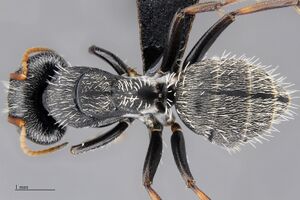 
| |
| . | Owned by Museum of Comparative Zoology. |
Minor Worker
   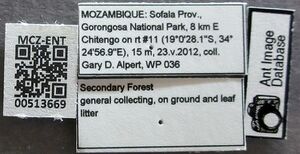
| |
| . | |
Images from AntWeb
   
| |
| Worker. Specimen code casent0178199. Photographer Erin Prado, uploaded by California Academy of Sciences. | Owned by CAS, San Francisco, CA, USA. |
       
| |
| Worker (major/soldier). Specimen code casent0102315. Photographer April Nobile, uploaded by California Academy of Sciences. | Owned by NHMUK, London, UK. |
 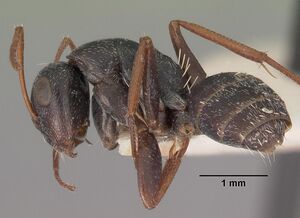  
| |
| Worker. Specimen code casent0102314. Photographer April Nobile, uploaded by California Academy of Sciences. | Owned by NHMUK, London, UK. |
   
| |
| Worker (major/soldier). Specimen code casent0102316. Photographer April Nobile, uploaded by California Academy of Sciences. | Owned by NHMUK, London, UK. |
   
| |
| Worker. Specimen code casent0102447. Photographer April Nobile, uploaded by California Academy of Sciences. | Owned by MHNG, Geneva, Switzerland. |
 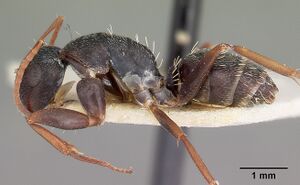 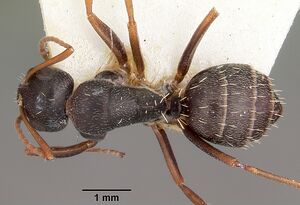 
| |
| Type of unavailable quadrinomial: Camponotus foraminosus aldabrensis fryeri. Worker. Specimen code casent0104617. Photographer April Nobile, uploaded by California Academy of Sciences. | Owned by ZMHB, Berlin, Germany. |
   
| |
| Type of Camponotus foraminosus aldabrensis. Worker (major/soldier). Specimen code casent0104618. Photographer April Nobile, uploaded by California Academy of Sciences. | Owned by ZMHB, Berlin, Germany. |
 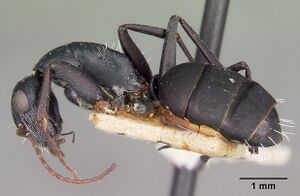  
| |
| Type of Camponotus foraminosus aldabrensis. Worker. Specimen code casent0104619. Photographer April Nobile, uploaded by California Academy of Sciences. | Owned by ZMHB, Berlin, Germany. |
  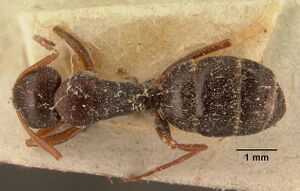 
| |
| Worker. Specimen code casent0101126. Photographer April Nobile, uploaded by California Academy of Sciences. | Owned by NHMB, Basel, Switzerland. |
   
| |
| Lectotype of Camponotus olivieri fryeri. Worker. Specimen code casent0910490. Photographer Will Ericson, uploaded by California Academy of Sciences. | Owned by MHNG, Geneva, Switzerland. |
   
| |
| Paralectotype of Camponotus olivieri fryeri. Worker (major/soldier). Specimen code casent0910489. Photographer Will Ericson, uploaded by California Academy of Sciences. | Owned by MHNG, Geneva, Switzerland. |
    
| |
| Worker. Specimen code casent0102448. Photographer April Nobile, uploaded by California Academy of Sciences. | Owned by MHNG, Geneva, Switzerland. |
Queen
Images from AntWeb
    
| |
| Queen (alate/dealate). Specimen code casent0102450. Photographer April Nobile, uploaded by California Academy of Sciences. | Owned by MHNG, Geneva, Switzerland. |
Male
Images from AntWeb
   
| |
| Male (alate). Specimen code casent0102449. Photographer April Nobile, uploaded by California Academy of Sciences. | Owned by MHNG, Geneva, Switzerland. |
Nomenclature
The following information is derived from Barry Bolton's Online Catalogue of the Ants of the World.
- auropubens. Camponotus foraminosus r. auropubens Forel, 1894b: 67 (s.w.) MOZAMBIQUE.
- Type-material: lectotype major worker (by designation of Rakotonirina, et al. 2017: 218), 1 paralectotype worker.
- Type-locality: lectotype Mozambique: Delagoa Bay (Liengme); paralectotype with same data.
- Type-depositories: MHNG (lectotype); NHMB (paralectotype).
- Combination in C. (Myrmotrema): Santschi, 1914e: 41.
- Subspecies of grandidieri: Mayr, 1895: 150.
- Subspecies of foraminosus: Emery, 1895a: 182; Emery, 1896d: 376 (in list); Emery, 1896i: 159; Emery, 1897e: 604; Forel, 1907g: 90; Forel, 1909b: 66; Santschi, 1914e: 41; Wheeler, W.M. 1922a: 250, 979.
- Status as species: Santschi, 1915c: 267 (in key), 274; Arnold, 1924: 728; Emery, 1925b: 131; Bolton, 1995b: 87; Rakotonirina, et al. 2017: 218 (redescription).
- Senior synonym of aldabrensis: Rakotonirina, et al. 2017: 218.
- Senior synonym of fryeri: Rakotonirina, et al. 2017: 218.
- Distribution: Democratic Republic of Congo, Ethiopia, Madagascar, Mozambique, Seychelles, Somalia, South Africa.
- Current subspecies: nominal plus absalon, argentopubens, jacob.
- aldabrensis. Camponotus foraminosus r. aldabrensis Forel, 1897c: 203 (s.w.) SEYCHELLES (Aldabra).
- Type-material: lectotype minor worker (by designation of Rakotonirina, et al. 2017: 218); paralectotype major and minor workers (numbers not stated).
- [Notes (i): original type-series contained major and minor workers; (ii) other original syntypes perhaps also MHNG.]
- Type-locality: lectotype Seychelles: Aldabra I. (A. Voeltzkow); paralectotypes with same data.
- Type-depository: MCZC (lectotype); MCZC, MHNG (paralectotypes).
- Combination in C. (Myrmotrema): Santschi, 1915c: 267.
- Subspecies of foraminosus: Emery, 1898a: 227; Santschi, 1911e: 133; Forel, 1912k: 166; Wheeler, W.M. 1922a: 1050.
- Subspecies of auropubens: Santschi, 1915c: 267 (in key); Emery, 1925b: 131; Bolton, 1995b: 85; Dorow, 1996a: 85.
- Junior synonym of auropubens: Rakotonirina, et al. 2017: 218.
- fryeri. Camponotus (Myrmotrema) olivieri st. freyeri Santschi, 1915c: 270 (in key).
- [First available use of Camponotus foraminosus subsp. aldabrensis var. fryeri Forel, 1912k: 166 (w.) SEYCHELLES (Aldabra); unavailable (infrasubspecific) name.]
- Type-material: lectotype minor worker (by designation of Rakotonirina, et al. 2017: 219), 1 paralectotype major worker, 1 paralectotype minor worker.
- Type-locality: lectotype Seychelles: Aldabra I., 1908 (Fryer); paralectotypes with same data.
- Type-depository: MHNG (lectotype); MHNG, MNHU (paralectotypes).
- [Justified emendation of spelling to fryeri: Emery, 1925b: 132 (as original collector named as Fryer, in Forel, 1912k: 166).]
- Subspecies of olivieri: Emery, 1925b: 132; Bolton, 1995b: 100; Dorow, 1996a: 85.
- Junior synonym of auropubens: Rakotonirina, et al. 2017: 219.
Unless otherwise noted the text for the remainder of this section is reported from the publication that includes the original description.
Description
Worker
Rakotonirina et al. (2017) – Minor In full-face view head small (CS: 1.36±0.14; 1.19–1.70) and longer than broad (CWb/CL: 0.88±0.03; 0.84–0.92), lateral margins roughly straight and slightly converging anteriorly; posterior margin more or less convex. Median portion of clypeus transversely trapezoidal (ClyL/GPD: 0.70±0.03; 0.65– 0.79). Eyes rarely breaking lateral outlines of head, their posterior level located at posterior fifth portion of head (PoOc/CL: 0.19±0.01; 0.18–0.21). Anterior clypeal margin truncate with blunt lateral angle; posterior margin weakly notched medially. Mandible triangular, masticatory margin with six sharp teeth. Antennal scape long, roughly its apical third portion extending beyond posterior cephalic border. In lateral view, promesonotal dorsum generally convex, without anterior and dorsolateral margination; propodeal dorsum straight and inclined posteriorly. In dorsal view, mesosoma widest at level of pronotum and decreasing in width towards propodeal declivity; propodeum tapering dorsally. Opening of propodeal spiracle slitlike. Petiolar node flattened anteroposteriorly and tapering dorsally. Tibial spurs of middle and hind legs pectinate.
Dorsum of head and mesosoma with much finer and denser reticulate punctures than lateral portion. Gastral tergites finely and densely reticulate-punctate. Mandible imbricate-punctate. Whitish erect hairs thinner on dorsum of head and promesonotum, becoming thicker on propodeum, petiolar node, and gastral segments. Composition of hairs: a few pairs on median portion of head from clypeus to near posterior cephalic margin; pronotum with a few pairs, mesonotum with one to three pairs, propodeal dorsum and junction of lateral propodeal surface and declivity with scattered hairs. Posterodorsal angle of propodeum, junction between lateral propodeal surface, and declivity and dorsalmost posterolateral margin of petiolar node with whitish erect hairs shorter than distance between opening of propodeal spiracle and posteroventral angle of mesosoma. Pubescence on dorsum of body longer than distance between hairs; pubescence present on upper half of mesopleuron. Body color black and more or less matte; appendages basally reddish or dark brown, apical portion and antennae brown to light brown.
Major Characteristics of minor worker, except: head much larger and subquadrate (CS: 1.98±0.32; 1.54–2.41; CWb/CL: 1.02±0.07; 0.91–1.10); lateral margins broadly convex. Mandible more strongly built. Median portion of clypeus elongate and more rectangular (ClyL/GPD: 0.88±0.07; 0.78–0.97; ClyL/CL: 0.37±0.11; 0.32–0.61). Eyes located medially farther from lateral border of head (CWb/CL: 1.02±0.07; 0.91–1.10; CW/CL: 0.90±0.04; 0.86–0.97), their posterior margins level at posterior fourth of head capsule (PoOc/CL: 0.22±0.02; 0.19–0.26). Roughly one fourth of apical portion of scape extending beyond posterior cephalic margin. In dorsal view, metanotal groove slightly impressed; metanotum not visible. Sculpture of lateral portion of head from near base of mandible, along level of frontal carina to near posterior cephalic margin imbricate, superimposed with larger punctures that are equipped with two to five smaller punctures from which one appressed hair arises. Whitish erect hairs numerous on promesonotum. Basal portion of legs and mandibles reddish to dark brown; apical portion and antenna much lighter in color.
Type Material
Rakotonirina et al. (2017) - Lectotype major worker, Mozambique, Delagoa Bay [Maputo] (Liengme), AntWeb CASENT0910475 (Musee d'Histoire Naturelle Genève) [examined]. Paralectotype worker of same data as lectotype but with specimen code: CASENT0911819 (Naturhistorisches Museum, Basel) [examined].
- Camponotus foraminosus auropubens: Syntype, 1 major worker, Maputo (as Delagoa Bay), Mozambique, Liengme, CASENT0910475, Musee d'Histoire Naturelle Genève; reported (but not designated) as lectotype by Rakotonirina, Csosz & Fisher, 2017: 218.
- Camponotus foraminosus auropubens: Syntype, 1 worker, Maputo (as Delagoa Bay), Mozambique, Liengme, CASENT0911819, Naturhistorisches Museum, Basel; reported (but not designated) as paralectotype by Rakotonirina, Csosz & Fisher, 2017: 218.
- Camponotus foraminosus aldabrensis: Syntype, 1 minor worker, Aldabra, Seychelles, Voeltzkow, CASENT0172791, Museum of Comparative Zoology; reported (but not designated) as lectotype by Rakotonirina, Csosz & Fisher, 2017: 218.
- Camponotus olivieri freyeri: Lectotype (designated by Rakotonirina, Csosz & Fisher, 2017: 219), minor worker, Aldabra, Seychelles, Fryer, CASENT0910490, Museum of Comparative Zoology.
- Camponotus olivieri freyeri: Paralectotype (designated by Rakotonirina, Csosz & Fisher, 2017: 219), 1 major worker, Aldabra, Seychelles, Fryer, CASENT0910489, Musee d'Histoire Naturelle Genève.
- Camponotus olivieri freyeri: Paralectotype (designated by Rakotonirina, Csosz & Fisher, 2017: 219), 1 minor worker, Aldabra, Seychelles, Fryer, CASENT0104617, Berlin Museum für Naturkunde der Humboldt-Universität.
References
- Arnold, G. 1924. A monograph of the Formicidae of South Africa. Part VI. Camponotinae. Ann. S. Afr. Mus. 14: 675-766 (page 728, raised to species)
- Bolton, B. 1995b. A new general catalogue of the ants of the world. Cambridge, Mass.: Harvard University Press, 504 pp. (page 87, catalogue)
- Emery, C. 1896j. Saggio di un catalogo sistematico dei generi Camponotus, Polyrhachis e affini. Mem. R. Accad. Sci. Ist. Bologna (5)5:363-382 (page 376, subspecies of foraminosus)
- Emery, C. 1925d. Hymenoptera. Fam. Formicidae. Subfam. Formicinae. Genera Insectorum 183: 1-302 (page 131, raised to species)
- Forel, A. 1894b. Abessinische und andere afrikanische Ameisen, gesammelt von Herrn Ingenieur Alfred Ilg, von Herrn Dr. Liengme, von Herrn Pfarrer Missionar P. Berthoud, Herrn Dr. Arth. Müller etc. Mitt. Schweiz. Entomol. Ges. 9: 64-100. (page 67, worker described)
- Mayr, G. 1895. Afrikanische Formiciden. Ann. K-K. Naturhist. Mus. Wien 10: 124-154 (page 150, subspecies of grandidieri)
- Rakotonirina, J.C., Csosz, S., Fisher, B.L. 2017. Taxonomic revision of the Malagasy Camponotus grandidieri and niveosetosus species groups (Hymenoptera, Formicidae) using qualitative and quantitative morphology. Zootaxa 4238: 203–245 (doi:10.11646/zootaxa.4238.2.2).
- Santschi, F. 1914e. Meddelanden från Göteborgs Musei Zoologiska Afdelning. 3. Fourmis du Natal et du Zoulouland récoltées par le Dr. I. Trägårdh. Göteb. K. Vetensk. Vitterh. Samh. Handl. 15: 1-44 (page 41, combination in C. (Myrmotrema))
- Santschi, F. 1915c. Nouvelles fourmis d'Afrique. Ann. Soc. Entomol. Fr. 84: 244-282 (page 267, raised to species (in key))
- Wheeler, W. M. 1922b. Ants of the American Museum Congo expedition. A contribution to the myrmecology of Africa. II. The ants collected by the American Museum Congo Expedition. Bull. Am. Mus. Nat. Hist. 45: 39-269 (page 250, subspecies of foraminosus)
References based on Global Ant Biodiversity Informatics
- Arnold G. 1924. A monograph of the Formicidae of South Africa. Part VI. Camponotinae. Annals of the South African Museum 14: 675-766.
- Dorow, Wolfgang H. O. 1995. Review and Bibliography of the ants of the Seychelles (Hymenoptera: Formicidae). J. Afr. Zool. 110:73-96
- Dorow, Wolfgang H.O. 1996. Review and bibliography of the ants of the Seychelles. Journal of African Zoology 110(2): 73-95.
- Fisher B. L. 1997. Biogeography and ecology of the ant fauna of Madagascar (Hymenoptera: Formicidae). Journal of Natural History 31: 269-302.
- Fisher B. L. 2003. Formicidae, ants. Pp. 811-819 in: Goodman, S. M.; Benstead, J. P. (eds.) 2003. The natural history of Madagascar. Chicago: University of Chicago Press, xxi + 1709 pp.
- Forel A. 1897. Ameisen aus Nossi-Bé, Majunga, Juan de Nova (Madagaskar), den Aldabra-Inseln und Sansibar, gesammelt von Herrn Dr. A. Voeltzkow aus Berlin. Mit einem Anhang über die von Herrn Privatdocenten Dr. A. Brauer in Marburg auf den Seychellen und von Herrn Perrot auf Ste. Marie (Madagaskar) gesammelten Ameisen. Abhandlungen der Senckenbergischen Naturforschenden Gesellschaft 21: 185-208.
- Forel A. 1912. The Percy Sladen Trust Expedition to the Indian Ocean in 1905, under the leadership of Mr. J. Stanley Gardiner, M.A. Volume 4. No. XI. Fourmis des Seychelles et des Aldabras, reçues de M. Hugh Scott. Trans. Linn. Soc. Lond. Zool. (2) 15: 159-167.
- Menozzi C. 1930. Formiche della Somalia italiana meridionale. Memorie della Società Entomologica Italiana. 9: 76-130.
- Rakotonirina J. C., S. Csosz, and B. L. Fisher. 2017. Taxonomic revision of the Malagasy Camponotus grandidieri and niveosetosus species groups (Hymenoptera, Formicidae) using qualitative and quantitative morphology. Zootaxa 4238 (2): 203–245.
- Santschi F. 1911. Nouvelles fourmis de Madagascar. Revue Suisse de Zoologie 19: 117-134.
- Santschi F. 1915. Nouvelles fourmis d'Afrique. Annales de la Société Entomologique de France 84: 244-282.
- Wheeler W. M. 1922. Ants of the American Museum Congo expedition. A contribution to the myrmecology of Africa. II. The ants collected by the American Museum Congo Expedition. Bulletin of the American Museum of Natural History 45: 39-269.
- Wheeler W. M. 1922. Ants of the American Museum Congo expedition. A contribution to the myrmecology of Africa. IX. A synonymic list of the ants of the Malagasy region. Bulletin of the American Museum of Natural History 45: 1005-1055
- Wheeler W. M. 1922. Ants of the American Museum Congo expedition. A contribution to the myrmecology of Africa. VIII. A synonymic list of the ants of the Ethiopian region. Bulletin of the American Museum of Natural History 45: 711-1004

